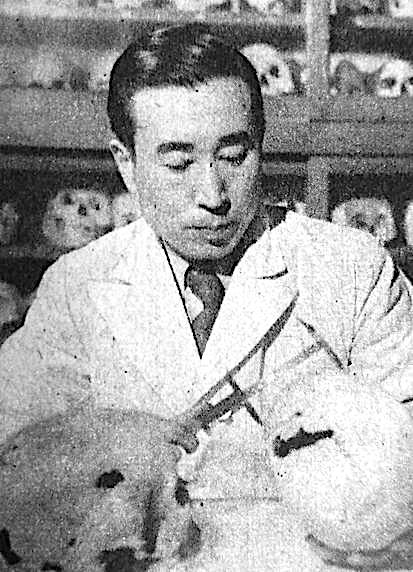
鈴木尚
Hisashi SUZUKI, 1912-2004
☆
鈴木 尚(すずき ひさし、1912年(明治45年)3月24日 -
2004年(平成16年)10月1日)は、日本の人類学者。縄文時代から現代に至る日本人の形質を人類学や解剖学の面から研究し、それまで知られていな
かった、歴史時代を通じての日本人の大きな形質変化を明らかにした事で著名。東京大学教授、国立科学博物館人類研究部長、成城大学教授を歴任。東京大学名
誉教授、医学博士。1998年紫綬褒章。
| Hisashi
Suzuki (March 24, 1912 - October 1, 2004) was a Japanese
anthropologist. He is well known for his anthropological and anatomical
studies of Japanese traits from the Jomon period to the present day,
and for his clarification of major trait changes in the Japanese people
throughout history, which had been previously unknown. He has served as
professor at the University of Tokyo, director of the Department of
Anthropology at the National Museum of Nature and Science, and
professor at Seijo University. He was awarded the Medal with Purple
Ribbon in 1998. |
鈴
木 尚(すずき ひさし、1912年(明治45年)3月24日 -
2004年(平成16年)10月1日)は、日本の人類学者。縄文時代から現代に至る日本人の形質を人類学や解剖学の面から研究し、それまで知られていな
かった、歴史時代を通じての日本人の大きな形質変化を明らかにした事で著名。東京大学教授、国立科学博物館人類研究部長、成城大学教授を歴任。東京大学名
誉教授、医学博士。1998年紫綬褒章。 |
| Career and Achievements Born in Hatogaya-cho (now Kawaguchi City), Saitama Prefecture. After graduating from Tokyo High School, entered the Faculty of Medicine at Tokyo Imperial University. In the summer of 1951, he discovered a group of skulls of unknown age and origin in the skeletal specimen room of the University of Tokyo and determined that they originated in the Muromachi Period. Since then, he has devoted his energies to the discovery and research of skeletons from various periods of Japanese history. At that time, there was little research on ancient human skeletons throughout the Japanese historical period, and it is fair to say that nothing was known about how Japanese people's traits had changed from ancient times to the present day. During the several years around 1955, Suzuki excavated about 2,000 remains of those who died in the battle that led to the downfall of the Kamakura shogunate in 1333, and also investigated remains excavated from cemetery sites in Tokyo during the Muromachi and Edo periods. As a result, he found, for example, that the head was long in the Kamakura period but gradually became shorter. As a result, it was found that, for example, the head was long during the Kamakura period (1185-1333) but gradually became shorter, that the root of the nose (bikon, meaning the bridge of the nose) was low throughout history but rapidly rose after the Meiji period (1868-1912), and that this trend is still ongoing. He has also conducted anthropological research on the mummies of the Oshu Fujiwara clan at Chuson-ji Temple (1950) and on the skeletons of the Tokugawa shoguns (1958), and has published his findings in books and on television. In 1961, he led an excavation team from the University of Tokyo to the Amud Cave in Israel, and became the first Japanese to successfully excavate the skeleton of a Neanderthal (Amudites). In Japan, fossil human skeletons have been discovered in Mikahi Man (Mikahi-cho, Hamana-ku, Hamamatsu City) as fossil extant humans and Ushikawa Man (Ushikawa Mine, Toyohashi City, Aichi Prefecture) as a possible Neanderthal stage, but later objections have been raised that the former is early Jomon Period and the latter is animal bones (Naumann elephant). |
経歴と業績 埼玉県鳩ヶ谷町(現、川口市)に生まれる。東京高等学校を経て東京帝国大学医学部に入学。解剖学教室で古人骨を研究していた小金井良精(こがねいよしき よ、こがねいりょうせい)の教えを受けた。1951年(昭和26年)夏、東京大学の骨格標本室で時代・出所不明の頭骨群を発見し、それが室町時代に由来す る事を突き止めて以来、日本の各時代の骨格の発見と研究に精力を注ぐようになった。当時は日本の歴史時代を通じての古人骨研究は殆ど行なわれておらず、古 代より現代までの間に日本人の形質がどう変化したかについては何もわかっていなかったと言ってよかった。 鈴木は、1955年(昭和30年)前後の数年間で、1333年の鎌倉幕府滅亡に至る戦闘の戦死者の遺骨を約2000体も発掘調査し、同じ頃に東京都内で室 町時代や江戸時代の墓地跡から出土した遺骨を調査するなど資料収集に力を注ぎ、その結果、例えば頭型は鎌倉時代には長頭であったがしだいに短頭化したこ と、鼻根(びこん。鼻筋を意味する)は歴史時代を通じて低かったが明治以降急速に高くなって現在も進行中であること、その他の時代による変化が明らかにさ れた。 また、中尊寺にあった奥州藤原氏のミイラの人類学的調査(1950年)や、徳川家代々の将軍の骨格の調査研究等も行ない(1958年)、その成果を書籍や テレビで一般にも公開するなど、世間の耳目を集める業績も多い。特に、1961年(昭和36年)には東京大学の発掘調査団を率いてイスラエルのアムッド洞 窟で、日本人としては初めてネアンデルタール人類(アムッド人)の全身骨格の発掘に成功した。 日本国内では、化石の現生人類として三ヶ日人(浜松市浜名区三ヶ日町)、ネアンデルタール段階と考えられるものとして牛川人(愛知県豊橋市牛川鉱山)など の化石人骨を発見しているが、その後、前者は縄文時代初期、後者は獣骨(ナウマンゾウ)ではないかとの異論が出されている。 |
| On the Theory of Japanese Origins Since the 1990s, there has been widespread support, including in the mass media, for the "dual structure theory" proposed by Kazuro Haniwara, Suzuki's academic successor, regarding the origin of the Japanese people. This theory holds that the Jomon people, who were the original inhabitants of the Japanese archipelago, were greatly influenced by the Yayoi people, who came from the continent, in the form of replacement and admixture, and formed the basis of the subsequent Japanese people. However, Suzuki, following in the footsteps of Hasebe Kotohito and others, and based on his own long years of research, especially detailed examination of human remains from the transition period from the Jomon to the Yayoi period, proposed the "deformation theory" that the Jomon people changed into the Yayoi people through so-called minor evolution due to changes in living environment caused by the influx of Yayoi culture. The "deformation theory" holds that the Jomon period people changed into the Yayoi period people through a so-called minor evolution due to changes in living environment caused by the influx of Yayoi culture. |
日本人起源論について 1990年代以降、日本人の起源をめぐっては、マスコミも含め、鈴木の学問上の後継者とも言える埴原和郎の提唱した「二重構造説」 が広く支持されている。これは日本列島の原住民であった縄文人が、大陸からの渡来人である渡来系弥生人から置換および混血という形で大きな影響を受け、そ の後の日本人の基盤が形成されたとするものである。しかし鈴木は、長谷部言人らの流れをくむと共に自らの長年の研究、なかんずく縄文時代から弥生時代へと 移行する時期の人骨の詳細な調査検討に基づき、縄文時代人が弥生文化の流入に伴う生活環境の変化のため、いわゆる小進化によって弥生時代人に変わったとい う「変形説」を主張した。 |
| 著作 『骨―日本人の祖先はよみがえる』学生社、1960年(改訂新版、1996) 『日本人の骨』岩波新書、1963年 『化石サルから日本人まで』岩波新書、1971年 『人体計測 マルチンによる計測法』人間と技術社 1973 『骨から見た日本人のルーツ』1983 岩波新書 『骨は語る 徳川将軍・大名家の人びと』東京大学出版会、1985 『鈴木尚骨格人類学論文集』鈴木尚先生傘寿記念会編 てらぺいあ 1992 『骨が語る日本史』学生社、1998年 共編 『増上寺徳川将軍墓とその遺品・遺体』矢島恭介、山辺知行共編、東京大学出版会、1967年 |
|
| ウィキペディア「鈴木尚」https://x.gd/CCzcO |
|
リ ンク
文 献
そ の他の情報
Copyleft, CC, Mitzub'ixi Quq Chi'j, 1996-2099
☆
 ☆
☆